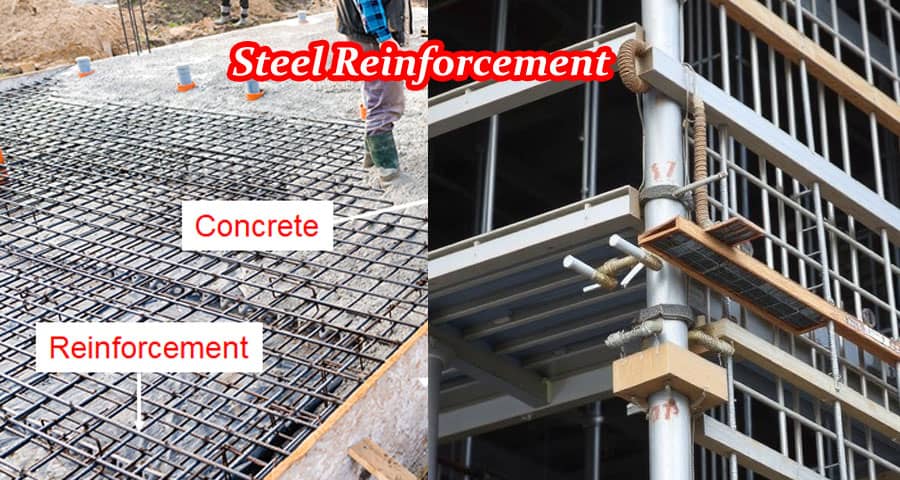What is the Steel Reinforcement Application in Building Construction?

Steel reinforcement plays a critical role in modern building construction, providing the necessary tensile strength to complement the compressive strength of concrete. This combination creates reinforced concrete structures capable of withstanding various loads and environmental conditions.
Importance of Steel Reinforcement in Construction
Concrete alone is strong in compression but weak in tension. Steel reinforcement compensates for this weak tensile strength, ensuring the durability and stability of concrete structures. The primary reasons for using reinforced concrete include:
- Enhanced Load-Bearing Capacity: Steel reinforcement allows structures to support heavier loads efficiently.
- Crack Resistance: Prevents excessive cracking and extends the lifespan of structures.
- Ductility: Provides flexibility to withstand stress without sudden failure.
- Structural Stability: Ensures resistance against environmental forces like earthquakes and strong winds.
- Longevity: Increases the durability of structures, reducing maintenance and repair costs.
Types of Steel Reinforcement Used in Construction
Various types of steel reinforcement are used in construction, each serving a specific purpose based on structural requirements.
1. Mild Steel Bars
Mild steel bars are plain round bars used in small-scale construction and non-structural elements. These bars have a smooth surface, offering limited bond strength with concrete. They are primarily used in projects where high bonding strength is not required.
2. Deformed Steel Bars (TMT Bars)
Thermo-Mechanically Treated (TMT) bars are ribbed bars offering superior bond strength with concrete. These bars are widely used due to their:
- High tensile strength
- Corrosion resistance
- Improved ductility
- Better bond with concrete
TMT bars are the preferred choice for multi-story buildings, bridges, and highways.
3. Welded Wire Mesh
Welded wire mesh consists of pre-welded steel wires arranged in a grid pattern. It is commonly used in slabs, walls, and roads to provide uniform reinforcement. Benefits include:
- Reduced labor costs
- Faster installation
- Consistent strength distribution
4. Epoxy-Coated Steel Bars
These bars have a protective epoxy coating to prevent corrosion. They are used in environments exposed to high moisture levels, such as marine structures and bridges.
5. Stainless Steel Reinforcement
Stainless steel bars offer superior corrosion resistance and longevity. While more expensive, they are ideal for structures requiring high durability, such as hospitals, tunnels, and coastal buildings.
6. Glass Fiber Reinforced Polymer (GFRP) Bars
An alternative to traditional steel reinforcement, GFRP bars are lightweight, corrosion-resistant, and non-conductive. These bars are used in bridges, tunnels, and chemically aggressive environments.
Applications of Steel Reinforcement in Building Construction
Steel reinforcement is used in nearly all structural elements of a building to improve its load-bearing capacity and stability.
1. Foundations
Steel reinforcement is essential in foundations to distribute loads from the structure to the soil. It prevents settling, cracking, and structural failure.
2. Beams and Columns
Beams and columns are primary load-bearing members in buildings. Reinforced concrete beams resist bending and shear forces, while columns handle compression and axial loads.
3. Slabs and Floors
Steel-reinforced concrete slabs provide stability and ensure even load distribution. They are commonly used in residential, commercial, and industrial buildings.
4. Walls and Retaining Structures
Steel reinforcement is used in shear walls and retaining walls to resist lateral forces from wind, earthquakes, and soil pressure.
5. Bridges and Highways
Bridges and highways require high-strength reinforcement to support dynamic loads and withstand environmental stressors.
6. Tunnels and Underground Structures
Steel reinforcement ensures structural integrity in underground structures, preventing collapse due to soil pressure.
Best Practices for Steel Reinforcement Application
To maximize the benefits of steel reinforcement in construction, certain best practices must be followed:
- Proper Placement: Reinforcement bars should be correctly positioned as per the structural design.
- Adequate Cover: Sufficient concrete cover must be provided to prevent corrosion.
- Correct Lap Length: Overlapping of steel bars should follow standard guidelines to maintain continuity.
- Use of Quality Materials: Always use high-grade steel to ensure strength and durability.
- Proper Binding and Tying: Steel bars should be securely tied with binding wire to prevent displacement during concrete pouring.
Conclusion
Steel reinforcement is a fundamental component in modern building construction, providing strength, durability, and stability to structures. By using the right type of steel reinforcement and following best practices, engineers can ensure long-lasting, safe, and efficient buildings.
Please watch the following short video for Steel Reinforcement Application in Building Construction
